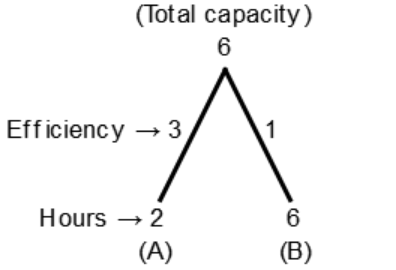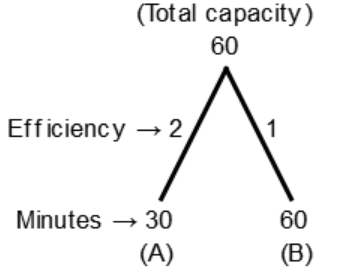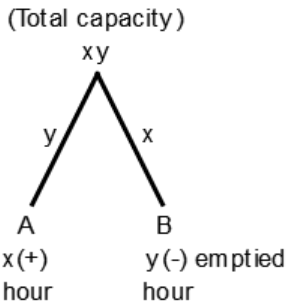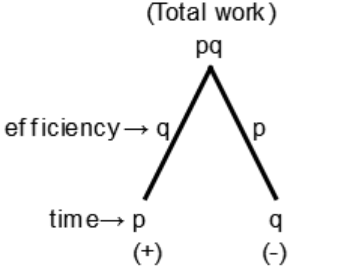1. Three pipes A, B and C can fill a tank from empty to full in 30 minutes, 20 minutes, and 10 minutes respectively. When the tank is empty, all the three pipes are opened. A, B and C discharge chemical solutions P, Q and R respectively. What is the proportion of the solution R in the liquid in the tank after 3 minutes?
a) $$\frac{5}{{11}}$$
b) $$\frac{6}{{11}}$$
c) $$\frac{7}{{11}}$$
d) $$\frac{8}{{11}}$$
Explanation: Part filled by (A + B + C) in 3 minutes
$$\eqalign{ & = 3\left( {\frac{1}{{30}} + \frac{1}{{20}} + \frac{1}{{10}}} \right) \cr & = {3 \times \frac{{11}}{{60}}} = \frac{{11}}{{20}} \cr & {\text{Part}}\,{\text{filled}}\,{\text{by}}\,{\text{C}}\,{\text{in}}\,{\text{3}}\,{\text{minutes}} = \frac{3}{{10}} \cr & {\text{Required}}\,{\text{ratio}} \cr & = {\frac{3}{{10}} \times \frac{{20}}{{11}}} = \frac{6}{{11}} \cr} $$
2. Pipes A and B can fill a tank in 5 and 6 hours respectively. Pipe C can empty it in 12 hours. If all the three pipes are opened together, then the tank will be filled in:
a) $$1\frac{{13}}{{17}}$$ hours
b) $$2\frac{8}{{11}}$$ hours
c) $$3\frac{9}{{17}}$$ hours
d) $$4\frac{1}{2}$$ hours
Explanation:
$$\eqalign{ & {\text{Net}}\,{\text{part}}\,{\text{filled}}\,{\text{in}}\,{\text{1}}\,{\text{hour}} \cr & = {\frac{1}{5} + \frac{1}{6} - \frac{1}{{12}}} = \frac{{17}}{{60}} \cr & {\text{The}}\,{\text{tank}}\,{\text{will}}\,{\text{be}}\,{\text{full}}\,{\text{in}}\,\frac{{60}}{{17}}\,{\text{hours}} \cr & i.e.,\,3\frac{9}{{17}}\,{\text{hours}} \cr} $$
Difference between their ages
$$\eqalign{ & = \left( {8x - 7x} \right) \cr & = {\text{ }}x\,{\text{years}} \cr & {\text{ = 2}}\,{\text{years}} \cr} $$
3. A pump can fill a tank with water in 2 hours. Because of a leak, it took $$2\frac{1}{3}$$ hours to fill the tank. The leak can drain all the water of the tank in:
a) $$4\frac{1}{3}$$ hours
b) 7 hours
c) 8 hours
d) 14 hours
Explanation: Work done by the leak in 1 hour
$$\eqalign{ & = {\frac{1}{2} - \frac{3}{7}} = \frac{1}{{14}} \cr} $$
Leak will empty the tank in 14 hours
4. Two pipes A and B can fill a cistern in $$37\frac{1}{2}$$ minutes and 45 minutes respectively. Both pipes are opened. The cistern will be filled in just half an hour, if the B is turned off after:
a) 5 min.
b) 9 min.
c) 10 min.
d) 15 min.
Explanation: Let B be turned off after x minutes.
Then, Part filled by (A + B) in x min. + Part filled by A in (30 - x) min. = 1
$$\eqalign{ & x\left( {\frac{2}{{75}} + \frac{1}{{45}}} \right) + \left( {30 - x} \right).\frac{2}{{75}} = 1 \cr & \frac{{11x}}{{225}} + \frac{{ {60 - 2x} }}{{75}} = 1 \cr & 11x + 180 - 6x = 225 \cr & x = 9 \cr} $$
5. A tank is filled by three pipes with uniform flow. The first two pipes operating simultaneously fill the tank in the same time during which the tank is filled by the third pipe alone. The second pipe fills the tank 5 hours faster than the first pipe and 4 hours slower than the third pipe. The time required by the first pipe is:
a) 6 hours
b) 10 hours
c) 15 hours
d) 30 hours
Explanation: Suppose, first pipe alone takes x hours to fill the tank.
Then, Second and third pipes will take (x - 5) and (x - 9) hours respectively to fill the tank.
$$\eqalign{ & \frac{1}{x} + \frac{1}{{ {x - 5} }} = \frac{1}{{ {x - 9} }} \cr & \frac{{x - 5 + x}}{{x\left( {x - 5} \right)}} = \frac{1}{{ {x - 9} }} \cr & \left( {2x - 5} \right)\left( {x - 9} \right) = x\left( {x - 5} \right) \cr & {x^2} - 18x + 45 = 0 \cr & \left( {x - 15} \right)\left( {x - 3} \right) = 0 \cr & x = 15{\kern 1pt} {\kern 1pt} {\kern 1pt} {\kern 1pt} {\kern 1pt} {\kern 1pt} \left[ {{\text{neglecting}}\,x = 3} \right] \cr} $$
6. A tap can completely fill a water tank in 8 hours. The water tank has a hole in it through which the water leaks out. The leakage will cause the full water tank to get empty in 12 hours. How much time will it take for the tap the the tank completely with the hole?
a) 16 hours
b) 18 hours
c) 24 hours
d) None of these
Explanation: Net part filled in 1 hour
$$\eqalign{ & {\text{ = }}\left( {\frac{1}{8} - \frac{1}{{12}}} \right) = \frac{1}{{24}} \cr} $$
The tank will be filled in 24 hours
7. A tank can be filled by pipe A in 2 hours and pipe B in 6 hours. At 10 A.M. pipe A was opened. At what time will the tank be filled if pipe B is opened at 11 A.M. ?
a) 12.45 A.M.
b) 5 P.M.
c) 11.45 A.M.
d) 12 P.M.
Explanation:

Pipe A will fill 3 units till 11 A.M. Remaining capacity
= 6 - 3
= 3 units
Now both pipes will fill the tank in
$$\frac{{{\text{Total Capacity}}}}{{{\text{Efficiency }}}} = \frac{3}{{\left( {3 + 1} \right)}} = \frac{3}{4}{\text{ hours}}$$
So, $$\left( {11 + \frac{3}{4}} \right)$$ A.M., tank will be filled = 11.45 A.M.
8. A water tank can be filled by a tap in 30 minutes and another tap can fill it in 60 minutes. If both taps are kept open for 5 minutes and then the first tap is closed, how long will it take foe the tank to be filled ?
a) 20 minutes
b) 25 minutes
c) 30 minutes
d) 45 minutes
Explanation:

(A + B)'s filling (2 + 1) = 3 units/min
In 5 minutes they will fill 3 × 5 = 15 units
Remaining capacity = 60 - 15 = 45 units
Second pipe (B) fills it in
$$\eqalign{ & = \frac{{{\text{Remaining capacity}}}}{{{\text{efficiency of B}}}} \cr & = \frac{{45}}{1} \cr & = \,45\,{\text{minutes}} \cr} $$
9. A pipe can fill a tank in x hours and another can empty it in y hours. In how many hours they together fill it in ( y > x) ?
a) (x - y) hours
b) (y - x) hours
c) $$\left( {\frac{{xy}}{{x - y}}} \right)\,{\text{hours}}$$
d) $$\left( {\frac{{xy}}{{y - x}}} \right){\text{hours}}$$
Explanation:

Time will be taken by both of them to fill the tank
$${\text{ = }}\frac{{xy}}{{y - x}}$$
10. A water tap fills a tub in 'p' hours and a sink at the bottom empties it in 'q' hours. If p < q and both tap and sink are opened the tank is filled in 'r' hours, then the relation between p, q, r :
a) $$\frac{1}{r} = \frac{1}{p} + \frac{1}{q}$$
b) $$\frac{1}{r} = \frac{1}{p} - \frac{1}{q}$$
c) $$r{\text{ = }}p{\text{ }} + {\text{ }}q$$
d) $${\text{ }}r{\text{ }} = {\text{ }}p{\text{ }} - {\text{ }}q$$
Explanation:

Net efficiency = q - p (∵ q > p)
Time required
$$\eqalign{ & {\text{r}} = \frac{{pq}}{{q - p}} \cr & or\,\frac{1}{r} = \frac{1}{p} - \frac{1}{q} \cr} $$